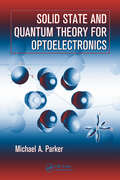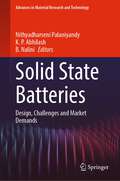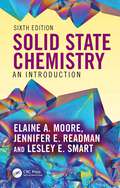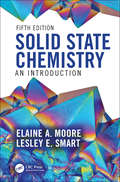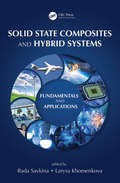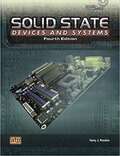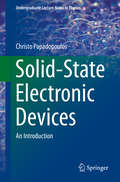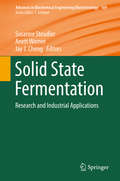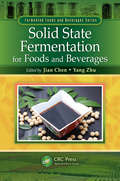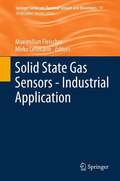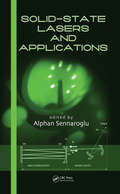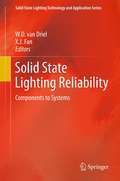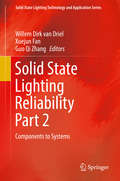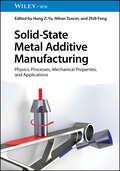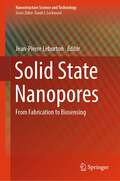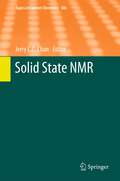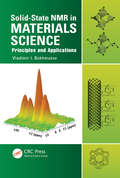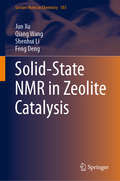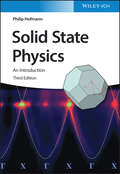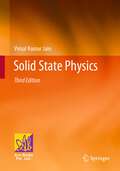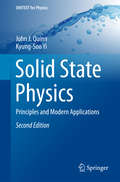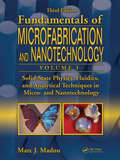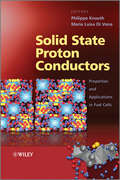- Table View
- List View
Solid State Additive Manufacturing
by Amlan Kar Zafar AlamThe text focuses on discussing the solid-state deformation behavior of materials in additive manufacturing processes. It highlights the process optimization and bonding of different layers during layer-by-layer deposition of different materials in Solid-State. It covers the design, process, and advancement of solid-state additive manufacturing methods. • Covers the fundamentals of materials processing, including the stress–strain–temperature correlation in solid-state processing and manufacturing. • Discusses solid-state additive manufacturing methods, and optimization strategies for the fabrication of additive manufacturing products. • Showcases the mechanisms associated with improvement in mechanical properties of Solid-State additive manufacturing products. • Provides a comprehensive discussion on microstructural stability and homogeneity in mechanical properties. • Presents hybrid solid-state process for fabrication of multilayer components and composite materials. • Provides a detailed review of laser-based post-processing techniques The text focuses on the Solid-State additive manufacturing techniques for the fabrication of industrially relevant products. It gives in-depth information on the fundamental aspects, hybridization of the processes, fabrication of different materials, improvement in product performance, and Internet of Things enabled manufacturing. The text covers crucial topics, including hybrid Solid- State additive manufacturing, cold spray additive manufacturing, online defect detection of products, and post-processing of additively manufactured components. These subjects are significant in advancing additive manufacturing technology and ensuring the quality and efficiency of the produced components. It will serve as an ideal reference text for senior undergraduate and graduate students, and researchers in fields such as mechanical engineering, aerospace engineering, manufacturing engineering, and production engineering. .
Solid State and Quantum Theory for Optoelectronics
by Michael A. ParkerWhile applications rapidly change one to the next in our commercialized world, fundamental principles behind those applications remain constant. So if one understands those principles well enough and has ample experience in applying them, he or she will be able to develop a capacity for reaching results via conceptual thinking rather than having to
Solid State Batteries: Design, Challenges and Market Demands (Advances in Material Research and Technology)
by Nithyadharseni Palaniyandy K. P. Abhilash B. NaliniThis book offers a comprehensive analysis of novel design strategies in higher energy solid-state lithium batteries. It describes synthesis and experimental techniques to characterize the physical, chemical and electrochemical properties of the electrode and electrolytes. The book reports on electrochemical measurements of conductivity and related parameters in solid electrolytes and its interfaces. It also presents various technologies that have been used for the fabrication of all-solid-state lithium-ion batteries such as thin-film, 3D printing (additive manufacturing) and atomic layer deposition. A large part of the text focus on the description on the complete functioning and challenges with the electrochemistry of the electrodes and solid electrolyte interfaces. The book also supplies valuable insight into potential growth opportunities in this exciting market and cost-effective design tactics in solid-state assemblies.
Solid State Chemistry: An Introduction
by Elaine A. Moore Jennifer ReadmanSolid State Chemistry: An Introduction 6th Edition is a fully revised edition of one of our most successful textbooks with at least 20% new information and new images of crystal structures.Solid-state chemistry is still a rapidly advancing field, contributing to areas such as batteries for transport and energy storage, nanostructured materials and porous materials for the capture of carbon dioxide and other pollutants.This edition aims, as previously, not only to teach the basic science that underpins the subject but also to direct the reader to the most modern techniques and to expanding and new areas of research. The user-friendly style takes a largely non-mathematical approach and gives practical examples of applications of solid-state materials and concepts.The chapter on sustainability written by an expert in the field has been updated, and examples of the relevance of solid-state chemistry to sustainability are used throughout. The chapter on batteries has been extended to include fuel cells.Other new topics in this edition include X-ray-free electron laser crystallography and thermal properties of materials.A companion website offering accessible resources for students and instructors alike, featuring topics and tools such as quizzes, videos, web links and more has been provided for this edition.
Solid State Chemistry: An Introduction
by Elaine A. Moore Lesley E. Smart"A comprehensive guide to solid-state chemistry which is ideal for all undergraduate levels. It covers well the fundamentals of the area, from basic structures to methods of analysis, but also introduces modern topics such as sustainability." Dr. Jennifer Readman, University of Central Lancashire, UK "The latest edition of Solid State Chemistry combines clear explanations with a broad range of topics to provide students with a firm grounding in the major theoretical and practical aspects of the chemistry of solids." Professor Robert Palgrave, University College London, UK Building a foundation with a thorough description of crystalline structures, this fifth edition of Solid State Chemistry: An Introduction presents a wide range of the synthetic and physical techniques used to prepare and characterise solids. Going beyond this, this largely nonmathematical introduction to solid-state chemistry includes the bonding and electronic, magnetic, electrical, and optical properties of solids. Solids of particular interest—porous solids, superconductors, and nanostructures—are included. Practical examples of applications and modern developments are given. It offers students the opportunity to apply their knowledge in real-life situations and will serve them well throughout their degree course. New in the Fifth Edition A new chapter on sustainability in solid-state chemistry written by an expert in this field Cryo-electron microscopy X-ray photoelectron spectroscopy (ESCA) Covalent organic frameworks Graphene oxide and bilayer graphene Elaine A. Moore studied chemistry as an undergraduate at Oxford University and then stayed on to complete a DPhil in theoretical chemistry with Peter Atkins. After a two-year postdoctoral position at the University of Southampton, she joined the Open University in 1975, becoming a lecturer in chemistry in 1977, senior lecturer in 1998, and reader in 2004. She retired in 2017 and currently has an honorary position at the Open University. She has produced OU teaching texts in chemistry for courses at levels 1, 2, and 3 and written texts in astronomy at level 2 and physics at level 3. She was team leader for the production and presentation of an Open University level 2 chemistry module delivered entirely online. She is a Fellow of the Royal Society of Chemistry and a Senior Fellow of the Higher Education Academy. She was co-chair for the successful Departmental submission of an Athena Swan bronze award. Lesley E. Smart studied chemistry at Southampton University, United Kingdom. After completing a PhD in Raman spectroscopy, she moved to a lectureship at the (then) Royal University of Malta. After returning to the United Kingdom, she took an SRC Fellowship to Bristol University to work on X-ray crystallography. From 1977 to 2009, she worked at the Open University chemistry department as a lecturer, senior lecturer, and Molecular Science Programme director, and she held an honorary senior lectureship there until her death in 2016. At the Open University, she was involved in the production of undergraduate courses in inorganic and physical chemistry and health sciences. She served on the Council of the Royal Society of Chemistry and as the chair of their Benevolent Fund.
Solid State Composites and Hybrid Systems: Fundamentals and Applications
by Rada Savkina Larysa KhomenkovaSolid state composites and hybrid systems offer multifunctional applications in various fields of human life, demonstrating solutions to the key problems of the environment, human health, biology, medicine, electronics, energy harvesting and storage. Exploring this innovative field of research, this book details the wide range of materials, techniques, and approaches utilised in composite and hybrid structures in recent years. It will be of interest not only for experienced researchers but also for postgraduate students and young researchers entering the fields of nanoscience, material sciences, and bioengineering. Features: Contains the latest research developments in the materials, techniques, patents, and approaches in the field Includes both fundamental aspects and applied research Edited by two highly experienced researchers
Solid State Devices and Systems
by Gary J. RockisThis textbook presents a comprehensive overview of solid state devices and circuits. Component and circuit construction, operation, and installation are supported by detailed illustrations. Practical applications are included.
Solid-State Electronic Devices
by Christo PapadopoulosA modern and concise treatment of the solid state electronic devices that are fundamental to electronic systems and information technology is provided in this book. The main devices that comprise semiconductor integrated circuits are covered in a clear manner accessible to the wide range of scientific and engineering disciplines that are impacted by this technology. Catering to a wider audience is becoming increasingly important as the field of electronic materials and devices becomes more interdisciplinary, with applications in biology, chemistry and electro-mechanical devices (to name a few) becoming more prevalent. Updated and state-of-the-art advancements are included along with emerging trends in electronic devices and their applications. In addition, an appendix containing the relevant physical background will be included to assist readers from different disciplines and provide a review for those more familiar with the area. Readers of this book can expect to derive a solid foundation for understanding modern electronic devices and also be prepared for future developments and advancements in this far-reaching area of science and technology.
Solid State Fermentation: Research and Industrial Applications (Advances in Biochemical Engineering/Biotechnology #169)
by Susanne Steudler Anett Werner Jay J. ChengThis book reviews the wide range of products and applications of solid state fermentation as well as the development of this cultivation technology over the last years. In this book, readers will also learn about the challenges of solid state fermentation, including process management, reactor design, scale-up and the formation of process-specific products. Solid fermentation is a traditional cultivation technique of food technology and involves all cultivations of microorganisms on a solid substrate without free liquid phase. In the course of development of Biotechnology it was replaced by liquid cultivation mainly in the western countries. Over the past few years, solid-state fermentation is now becoming more important and has moved more back into focus. Especially, it is suitable for the cultivation of filamentous organisms, like ascomycetes and basidiomycetes, but also for various yeasts and bacteria. The products and applications of solid-state fermentation are as diverse as the microorganisms. They range from enzyme production to the production of antibiotics and pigments to the use in environmental technology and energy production.
Solid State Fermentation for Foods and Beverages (Fermented Foods and Beverages Series #2)
by Jian Chen Yang ZhuAlthough one of the oldest microbial technologies used in food processing, solid-state fermentation (SSF) had, until recently, fallen out of favor. However, based on a series of established mathematical models, new design concepts for SSF bioreactors and process control strategies have been proposed, allowing SSF technology to reach new levels. Sol
Solid State Gas Sensors - Industrial Application
by Maximilian Fleischer Mirko LehmannGas sensor products are very often the key to innovations in the fields of comfort, security, health, environment, and energy savings. This compendium focuses on what the research community labels as solid state gas sensors, where a gas directly changes the electrical properties of a solid, serving as the primary signal for the transducer. It starts with a visionary approach to how life in future buildings can benefit from the power of gas sensors. The requirements for various applications, such as for example the automotive industry, are then discussed in several chapters. Further contributions highlight current trends in new sensing principles, such as the use of nanomaterials and how to use new sensing principles for innovative applications in e.g. meteorology. So as to bring together the views of all the different groups needed to produce new gas sensing applications, renowned industrial and academic representatives report on their experiences and expectations in research, applications and industrialisation.
Solid State Gas Sensors - Industrial Application (Springer Series on Chemical Sensors and Biosensors #11)
by Maximilian Fleischer Mirko LehmannGas sensor products are very often the key to innovations in the fields of comfort, security, health, environment, and energy savings. This compendium focuses on what the research community labels as solid state gas sensors, where a gas directly changes the electrical properties of a solid, serving as the primary signal for the transducer. It starts with a visionary approach to how life in future buildings can benefit from the power of gas sensors. The requirements for various applications, such as for example the automotive industry, are then discussed in several chapters. Further contributions highlight current trends in new sensing principles, such as the use of nanomaterials and how to use new sensing principles for innovative applications in e.g. meteorology. So as to bring together the views of all the different groups needed to produce new gas sensing applications, renowned industrial and academic representatives report on their experiences and expectations in research, applications and industrialisation.
Solid-State Lasers and Applications (Optical Science and Engineering)
by Alphan SennarogluBecause of the favorable characteristics of solid-state lasers, they have become the preferred candidates for a wide range of applications in science and technology, including spectroscopy, atmospheric monitoring, micromachining, and precision metrology. Presenting the most recent developments in the field, Solid-State Lasers and Applications focuses on the design and applications of solid-state laser systems.With contributions from leading international experts, the book explores the latest research results and applications of solid-state lasers as well as various laser systems. The beginning chapters discuss current developments and applications of new solid-state gain media in different wavelength regions, including cerium-doped lasers in the ultraviolet range, ytterbium lasers near 1µm, rare-earth ion-doped lasers in the eye-safe region, and tunable Cr2+:ZnSe lasers in the mid-infrared range. The remaining chapters study specific modes of operation of solid-state laser systems, such as pulsed microchip lasers, high-power neodymium lasers, ultrafast solid-state lasers, amplification of femtosecond pulses with optical parametric amplifiers, and noise characteristics of solid-state lasers. Solid-State Lasers and Applications covers the most important aspects of the field to provide current, comprehensive coverage of solid-state lasers.
Solid State Lighting Reliability
by W.D. van Driel X. J. FanSolid State Lighting Reliability: Components to Systems begins with an explanation of the major benefits of solid state lighting (SSL) when compared to conventional lighting systems including but not limited to long useful lifetimes of 50,000 (or more) hours and high efficacy. When designing effective devices that take advantage of SSL capabilities the reliability of internal components (optics, drive electronics, controls, thermal design) take on critical importance. As such a detailed discussion of reliability from performance at the device level to sub components is included as well as the integrated systems of SSL modules, lamps and luminaires including various failure modes, reliability testing and reliability performance.
Solid State Lighting Reliability Part 2
by Willem Dirk van Driel Xuejun Fan Guo Qi ZhangIn the past four years we have witnessed rapid development in technology and significant market penetration in many applications for LED systems. New processes and new materials have been introduced; new standards and new testing methods have been developed; new driver, control and sensing technologies have been integrated; and new and unknown failure modes have also been presented. In this book, Solid State Lighting Reliability Part 2, we invited the experts from industry and academia to present the latest developments and findings in the LED system reliability arena. Topics in this book cover the early failures and critical steps in LED manufacturing; advances in reliability testing and standards; quality of colour and colour stability; degradation of optical materials and the associated chromaticity maintenance; characterization of thermal interfaces; LED solder joint testing and prediction; common failure modes in LED drivers; root causes for lumen depreciation; corrosion sensitivity of LED packages; reliability management for automotive LEDs, and lightning effects on LEDs. This book is a continuation of Solid State Lighting Reliability: Components to Systems (published in 2013), which covers reliability aspects ranging from the LED to the total luminaire or system of luminaires. Together, these two books are a full set of reference books for Solid State Lighting reliability from the performance of the (sub-) components to the total system, regardless its complexity.
Solid-State Metal Additive Manufacturing: Physics, Processes, Mechanical Properties, and Applications
by Hang Z. Yu Nihan Tuncer Zhili FengSolid-State Metal Additive Manufacturing Timely summary of state-of-the-art solid-state metal 3D printing technologies, focusing on fundamental processing science and industrial applications Solid-State Metal Additive Manufacturing: Physics, Processes, Mechanical Properties, and Applications provides detailed and in-depth discussion on different solid-state metal additive manufacturing processes and applications, presenting associated methods, mechanisms and models, and unique benefits, as well as a detailed comparison to traditional fusion-based metal additive manufacturing. The text begins with a high-level overview of solid-state metal additive manufacturing with an emphasis on its position within the metal additive manufacturing spectrum and its potential for meeting specific demands in the aerospace, automotive, and defense industries. Next, each of the four categories of solid-state additive technologies—cold spray additive manufacturing, additive friction stir deposition, ultrasonic additive manufacturing, and sintering-based processes—is discussed in depth, reviewing advances in processing science, metallurgical science, and innovative applications. Finally, the future directions of these solid-state processes, especially the material innovation and artificial intelligence aspects, are discussed. Sample topics covered in Solid-State Metal Additive Manufacturing include: Physical processes and bonding mechanisms in impact-induced bonding and microstructures and microstructural evolution in cold sprayed materialsProcess fundamentals, dynamic microstructure evolution, and potential industrial applications of additive friction stir depositionMicrostructural and mechanical characterization and industrial applications of ultrasonic additive manufacturingPrinciples of solid-state sintering, binder jetting-based metal printing, and sintering-based metal additive manufacturing methods for magnetic materialsCritical issues inherent to melting and solidification, such as porosity, high residual stress, cast microstructure, anisotropic mechanical properties, and hot cracking Solid-State Metal Additive Manufacturing is an essential reference on the subject for academic researchers in materials science, mechanical, and biomedicine, as well as professional engineers in various manufacturing industries, especially those involved in building new additive technologies.
Solid State Nanopores: From Fabrication to Biosensing (Nanostructure Science and Technology)
by Jean-Pierre LeburtonThis contributed volume provides an overview of the recent advances in solid-state nanopore technology, featuring contributions by leading experts in the field. It discusses several aspects of solid-state nanopores, covering their fabrication as well as multiple biosensing applications. It successfully bridges the gap between various scientific and engineering disciplines and highlights the progress made in this area. This title is a useful tool for acquiring basic knowledge of this field and following recent progress. It is a valuable contribution to the area of nanopore biosensing and is of interest to graduate students, postdocs, or senior researchers working in the fields of physical chemistry, biochemistry, bio- and electrical engineering, and biophysics.
Solid State NMR
by Jerry C. ChanDipolar Recoupling, by Niels Chr. Nielsen, Lasse A. Strassø and Anders B. Nielsen.- Solid-State NMR Techniques for the Structural Determination of Amyloid Fibrils, by Jerry C. C. Chan.- Solid-State 19F-NMR of Peptides in Native Membranes, by Katja Koch, Sergii Afonin, Marco Ieronimo, Marina Berditsch and Anne S. Ulrich.- Probing Quadrupolar Nuclei by Solid-State NMR Spectroscopy: Recent Advances, by Christian Fernandez and Marek Pruski.- Solid State NMR of Porous Materials Zeolites and Related Materials, by Hubert Koller and Mark Weiß.- Solid-State NMR of Inorganic Semiconductors, by James P. Yesinowski.-
Solid-State NMR in Materials Science: Principles and Applications
by Vladimir I. BakhmutovSolid-state NMR is a powerful physical method widely applied in modern fundamental and applied science, medicine, and industry. Its role is particularly valuable in materials chemistry due to the capability of solid-state NMR to rapidly solve tasks connected with structural descriptions of complex systems on macro and/or molecular levels, and the i
Solid-State NMR in Zeolite Catalysis (Lecture Notes in Chemistry #103)
by Jun Xu Qiang Wang Shenhui Li Feng DengSolid-State NMR Characterization of Heterogeneous Catalysts and Catalytic Reactions provides a comprehensive account of state-of-the-art solid-state NMR techniques and the application of these techniques in heterogeneous catalysts and related catalytic reactions. It includes an introduction to the basic theory of solid-state NMR and various frequently used techniques. Special emphasis is placed on characterizing the framework and pore structure, active site, guest-host interaction, and synthesis mechanisms of heterogeneous catalysts using multinuclear one- and two-dimensional solid-sate NMR spectroscopy. Additionally, various in-situ solid-state NMR techniques and their applications in investigation of the mechanism of industrially important catalytic reactions are also discussed. Both the fundamentals and the latest research results are covered, making the book suitable as a reference guide for both experienced researchers in and newcomers to this field.Feng Deng is a Professor at Wuhan Institute of Physics and Mathematics, Chinese Academy of Sciences.
Solid State Physics: An Introduction
by Philip HofmannEnables readers to easily understand the basics of solid state physics Solid State Physics is a successful short textbook that gives a clear and concise introduction to its subject. The presentation is suitable for students who are exposed to this topic for the first time. Each chapter starts with basic principles and gently progresses to more advanced concepts, using easy-to-follow explanations and keeping mathematical formalism to a minimum. This new edition is thoroughly revised, with easier-to-understand descriptions of metallic and covalent bonding, a straightforward proof of Bloch's theorem, a simpler approach to the nearly free electron model, and enhanced pedagogical features, such as more than 100 discussion questions, 70 problems--including problems to train the students’ skills to find computational solutions--and multiple-choice questions at the end of each chapter, with solutions in the book for self-training. Solid State Physics introduces the readers to: Crystal structures and underlying bonding mechanisms The mechanical and vibrational properties of solids Electronic properties in both a classical and a quantum mechanical picture, with a treatment of the electronic phenomena in metals, semiconductors and insulators More advanced subjects, such as magnetism, superconductivity and phenomena emerging for nano-scaled solidsFor bachelor’s students in physics, materials sciences, engineering sciences, and chemistry, Solid State Physics serves as an introductory textbook, with many helpful supplementary learning resources included throughout the text and available online, to aid in reader comprehension.
Solid State Physics
by Vimal Kumar JainThe book has been designed as a textbook for graduate and postgraduate students of physics, material science, and engineering. This is the third edition of the textbook, that is updated to reflect recent works in the field. In this edition, some new topics have been introduced while some of the existing topics like phonons, Drude –Lorentz model, Fermi levels, electrons, and holes, etc. are modified. Moreover, the book has complete information on semiconductor devices like tunnel diode, Gunn diode, photodiode, photoconductive diode, varactor diode, solar cell, LED, semiconductor lasers, and semiconductor detectors. All the chapters have been supplemented by solved and unsolved examples. Some of the chapters illustrate areas of current interest in solid-state physics to give the student practical working knowledge of the subject text in a simple and lucid manner. There is a fair amount of detail in the examples and derivations given in the text. Each section of the book has exercises to reinforce the concepts, and problems have been added at the end of each chapter. The detailed coverage and pedagogical tools make this an ideal textbook for students and researchers enrolled in graduate and postgraduate courses of physics, material science, and engineering.
Solid State Physics: Principles And Modern Applications
by John J. Quinn Kyung-Soo YiThis book provides the basis for a two-semester graduate course on solid-state physics. The first half presents all the knowledge necessary for a one-semester survey of solid-state physics, but in greater depth than most introductory solid state physics courses. The second half includes most of the important research over the past half-century, covering both the fundamental principles and most recent advances. This new edition includes the latest developments in the treatment of strongly interacting two-dimensional electrons and discusses the generalization from small to larger systems.The book provides explanations in a class-tested tutorial style, and each chapter includes problems reviewing key concepts and calculations. The updated exercises and solutions enable students to become familiar with contemporary research activities, such as the electronic properties of massless fermions in graphene and topological insulators.
Solid-State Physics, Fluidics, and Analytical Techniques in Micro- and Nanotechnology
by Marc J. MadouProviding a clear theoretical understanding of MEMS and NEMS, Solid-State Physics, Fluidics, and Analytical Techniques in Micro- and Nanotechnology focuses on nanotechnology and the science behind it, including solid-state physics. It provides a clear understanding of the electronic, mechanical, and optical properties of solids relied on in integra
Solid State Proton Conductors
by Philippe Knauth Maria Luisa Di VonaProton conduction can be found in many different solid materials, from organic polymers at room temperature to inorganic oxides at high temperature. Solid state proton conductors are of central interest for many technological innovations, including hydrogen and humidity sensors, membranes for water electrolyzers and, most importantly, for high-efficiency electrochemical energy conversion in fuel cells.Focusing on fundamentals and physico-chemical properties of solid state proton conductors, topics covered include:Morphology and Structure of Solid Acids Diffusion in Solid Proton Conductors by Nuclear Magnetic Resonance Spectroscopy Structure and Diffusivity by Quasielastic Neutron Scattering Broadband Dielectric Spectroscopy Mechanical and Dynamic Mechanical Analysis of Proton-Conducting Polymers Ab initio Modeling of Transport and Structure Perfluorinated Sulfonic Acids Proton-Conducting Aromatic Polymers Inorganic Solid Proton Conductors Uniquely combining both organic (polymeric) and inorganic proton conductors, Solid State Proton Conductors: Properties and Applications in Fuel Cells provides a complete treatment of research on proton-conducting materials.

